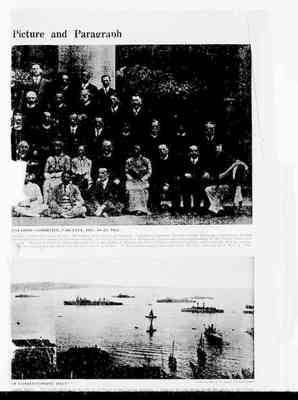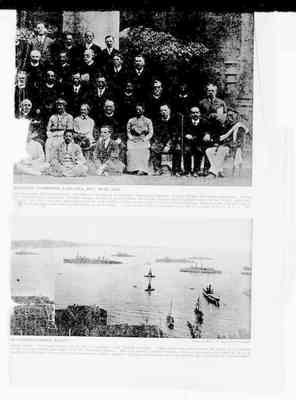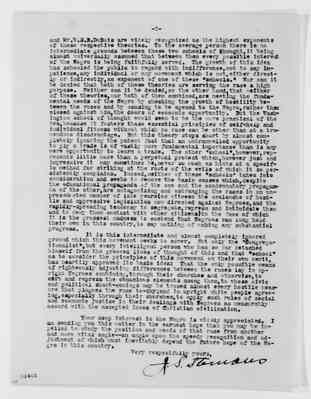Pages
716
Picture and Paragraph
[?]TINUATION COMMITTEE, CALCUTTA, DEC. 18-21, 1912
[?]ting the London Missionary Society; the United Free Church of Scotland; Evangelical Lutheran; Friends Foreign Missionary Assoclation; Society [?]nd Swedish societies; numerous Christian colleges; as well as Presbyterians, Methodists, Baptists and Congregationalists of the United States and [?]the left. The first in that row, beginning at the left, is the Bishop of Madras, the third is Bishop designate Azariah; while next Mr. Mott are seated, [?]wn American Board and third from the end is Dr. R. A. Hume. At the extreme right of the front row is Mr. E. C. Carter of the Y. M.C. A. For [?]
IN CONSTANTINOPLE HARBOR Photo by Rev. C. T. Riggs, Constantinople
[?]ament House. The small warship at the left of the house is the Turkish Izzeddin. Away at the left, barely inside the photo, is the British [?]
717
TINUATION COMMITTEE, CALCUTTA, DEC. 18-21, 1912 ting the London Missionary Society; the united Free Church of Scotland; Evangelical Lutheran; Friends Foreign Missionary Association and Swedish societies; numerous Christian colleges; The first in that row, beginning at the left, is the Bishop of Madras, the third is Bishop designate Arariah; while next Mr. Mott are seated, wn American Board and third from the end is Dr. R.A. Hume. At the extreme right of the front row is Mr. E. C. Carter of the Y.M.C.A. For
IN CONSTANTINOPLE HARRO
Photo 6y Rev. C. T. Kivos, Constantinople
ament House. The small warship at the left of the thouse is the Turkish Izzeddin Away at the left, barely inside the photo, is the British th still a third in midstream rather near the Parliament House. The ship nearest Leander's Tower, which is the small white tower off shore in the group at the right of the picture includes another Italian, one more French, a Roumanian, two more British, one Dutch and the representative
718
152
[stamp: MAR 11, 1913]
[stamp: THE WHITE HOUSE Mar. 1913 Received]
President Woodrow Wilson, 1251 South 18th Street
White House, PHILADELPHIA PA, March 10, 1913. Washington, D.C.
Dear President Wilson:
I am sending you under separate cover a marked cooy of The Congregationalist of Boston, containing a brief article by me on what I designated as "Growing Antipathy and Antagonism between the White and Negro Races-The Effect Cause and Cure", but which was inappropriately changed by the editor to read "Race Prejudice in Labor-The Effect, Cause and Cure", which I beg of you to read with extreme care. The article also was greatly condensed by the editor, and much of its original scope and force therefore destroyed. But the methods there briefly suggested for adjusting certain vital relations betwen the races(which methods for nearly two decades I have expended every energy in an effort to induce the public to pause long enough in their precipitate rush toward chaos and confusion on this question to soberly consider) are based almost whol1y on the proposition that it is within the province of the Church, as a collective body, to, by precept and example, fix and maintain those standards of relations between the races, especially along economic lines, regarding the justice and expediency of which the various churches are already a virtual unit in sentiment. In other words, I have ever maintained that the standards for certain imperative relations between the races should be dictated and controiled by concurrent agreement among the various churches, recognized as our highest exponents of civilization, rather than by the erratic and controversial contentions of the irresponsible demagogues of either race.
But my efforts to seriously turn the attention of the public to this most simple and immediately effective of all methods for adjusting adjustable relations between theraces have been more and more hampered and discouraged by a disposition on the part of the public, responding to the preachings of certain well-meaning but strangely narrow-visioned leaders of thought among both races, to group themselves into one of two "schools of thought" on this question. One of these "schools", with optimism, in season and out of season, as its keynote, insists that, through the spread of certain kinds of education, the problens of the Negro are even now in process of steady and satisfactory solution. Any adverse manifestations which at times may appear against the Negro are, according to this "school", but natural sequences in the process of mutual adjustment between two dissimilar races, which can have no other permanent results than to spur the Negro to renewed and higher efforts.
The other "school" frankly admits that there is an appalling retrograde movement of the race situation; but contends that the remedy lay in sweeping protests against every form of injustice, and in uncompromising demands for certain "manhood rights" of a civil and political nature. It may be said that Mr Booker T. Washington
38400 237
719
-2-
and Mr. V.R.B.Dubois are widely recognised as the highest exponents of these respective theories. To the average person there is no intermediate grounds between these two schools of thought, it being almost universally assumed that between them every possible interest of the Negro is being faithfully served. The growth of this idea has schooled the public to regard with indifference, not to say impatience, any individual or any movement which is not, either direct- ly or indirectly, an exponent of one of these "schools." Nor can it be denied that both of these theories are serving the race a high purpose. Neither can it be denied, on the other hand, that neither of these theories, nor both of them combined, are meeting the fundamental needs of the Negro by checking the growth of hostility between the races and by causing to be opened to the Negro, rather than closed against him, the doors of economic opportunity. But the Washington school of thought would seem to be the more practical of the two, because it fosters those essential principles of self-help and individual fitness without which no race can be other than at a tremendous disadvantage. But this theory stops short by almost completely ignoring the patent fact that an untrammelled opportunity to ply a trade is of vastly more fundamental importance than is any mere opportunity to learn a trade. The other "school', however represents little more than a perpetual protest which, however just and impressive it may sometimes be, never so much as hints at a specific method for striking at the roots of the evils of which it so persistently complains. Indeed, neither of these "schools" takes into consideration and seeks to remove the basic causes which, despite the educational propaganda of the one and the condemnatory propaganda of the other, are antagonizing and estranging the races in an unprecedented manner of late years (as witness the avalanche of hostile and oppressive legislation now directed against Negroes, and the rapidly-spreading tendency to segregate repress and intimidate them and to deny them contact with other citizens) in the face of which it is the grossest madness to contend that Negroes can long hord their own in this country, to say nothing of making any substantial progress.
It is this intermediate and almost completely ignored ground which this movement seeks to cover. Not only the "Congregationalist", but every intelligent person who has so far detached himself from the grooved lines of thought of this and that "school" as to consider the principles of this movement on their own merit, has heartily approved its basic idea: That the only possible means of righteously adjusting differences between the races lay in upright Negroes combining, through their churches and otherwise, to curb and repress the obnoxious elements among them, to whose civic and political short-comings may be traced almost every hostile measure that plagues the race to-day; and in upright white people agreeing, especially through their churches, to apply such rules of social and economic justice in their dealings with Negroes as measurably accord with the accepted ideas of Christian civilization.
Your deep interest in the Negro is widely appreciated. I am sending you this matter in the earnest hope that you may be impelled to study the position and needs of that race from another and more vital angle--an angle upon the speedy recognition and adjustment of which must inevitably depend the future hope of the Negro in this country.
Very respectfully yours,
J. S. [Stevons?] 83401
720
March 11, 1913
[152]
My dear Mr. Stemens:
The President directs me to acknowledge the receipt of your letter of March 10th, with accompanying copy of the Boston Congregationalist, and to say that the matter of which you write will have his earnest consideration.
Sincerely yours,
Secretary to the President
Mr. James S. Stemons, 1251 South Eighteenth Street, Phladelphia, Pennsylvania. 83402




